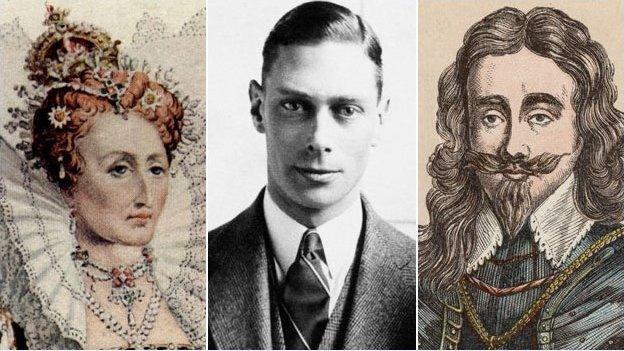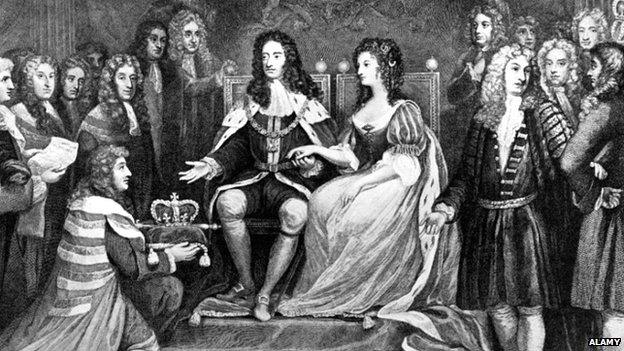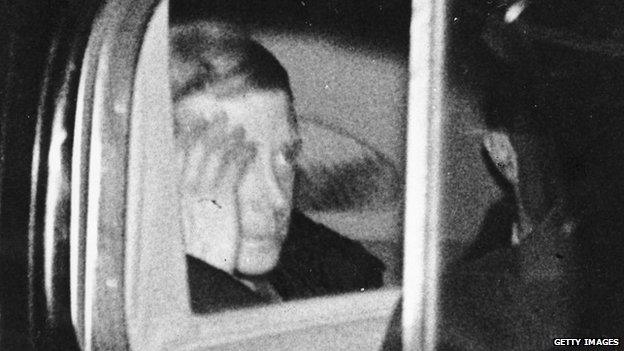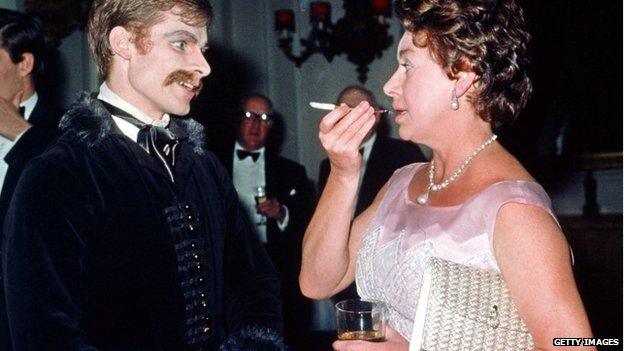The spares who became heirs
- Published

As fourth-in-line to the throne, the latest addition to the Duke and Duchess of Cambridge's family is unlikely to be monarch. But as history shows, being born second - or spare to the heir - doesn't always mean the top royal job is out of reach.
From the Anglo Saxon King of Wessex, Edward the Elder, to Elizabeth I, to the current Queen's own father, George VI, there are numerous examples of second-borns having assumed the throne.
The reasons are varied. The timeline of the kings and queens of England is littered with examples of treachery, adultery, murder and just plain bad luck.
But there are also the second-borns who missed out.
Spare a thought for William the Conqueror's second son, who was killed in a hunting accident. The throne of England was handed to his younger brother William Rufus, who himself died in a hunting accident decades later.
Then there was the second son of "mad king" George III, Prince Frederick, Duke of York and Albany, whose death from dropsy meant that after the death of George IV the job skipped to George III's third son, William IV.

Mary and husband William ascended the throne after her Catholic father was ousted
The fatal build-up of fluid meant Prince Frederick never became king, and instead the one-time commander in chief of the British army will forever be remembered for the key part he played in a national embarrassment, the failed Anglo-Russian invasion of Holland in 1799.
His legacy lies in the lines of a nursery rhyme, in which he is mockingly remembered as the Grand Old Duke of York, who marched his men up a hill and back down again.
And of course, the succession law that preferred males over females only changed in March, meaning many women throughout history have been overlooked in favour of their younger brothers.

Second-born traits
Second-born children are likely to be thinner in later life than their older siblings, according to a study by the University of Auckland.
They have more tact, make good negotiators and hold a lot more friends, says Australian parenting expert Michael Grose.
Researchers found first-born children more likely to be academic achievers, external, as well as being more conscientious, with this descending in birth order.
Austrian psychotherapist Alfred Adler drew the conclusion that second-borns have the opportunity to observe and profit from mistakes first-born children make.

Queen Victoria's eldest child was Victoria, Princess Royal, who became empress of Germany, and mother to the war-hungry Wilhelm II, the last German emperor, who abdicated in 1918 after losing World War One.
It fell to Victoria's second-born, though first son, Edward VII, to take the reins after his mother's 64 years at the helm ended.
Henry VIII's older sister was Margaret Tudor, whose marriage to King James IV of Scotland sowed the seeds for her great-grandson, James VI of Scotland, to become king of England and Ireland in 1603.
Of course in years past, the laws of succession were quite elastic.
Henry VII's claim to the throne as a distant descendant of Edward III was more than tenuous.
As a result, his second son and successor Henry VIII was determined to secure the Tudor throne with a male heir, an effort which saw him ex-communicated from the Catholic Church and the establishment of the Church of England.
While it was third (legitimate) born Edward who was crowned first of Henry's children, it was second-born Elizabeth I who will be forever remembered as one of England's greatest monarchs.
But when it comes to treachery in the family, nothing quite beats the Plantagenets, who ruled England (and large parts of France) from 1154 until 1485.

Edward VIII after announcing his unprecedented abdication
Take the sons of Henry II and Eleanor of Aquitaine.
Heir and second-born son, Henry the Young King, was crowned King of England during Henry II's lifetime in a failed attempt to avoid any succession disputes.
In the event, after a falling out, the young Henry died from dysentery while fighting a campaign against his father and brother Richard (the Lionheart).
His brothers Richard and John both went on to lead England, one after the other after siding against their father.
The desertion of Henry II's favourite son, John, is said to have contributed to his death.
Meanwhile, shoot forward to the 17th Century and James I's second son Charles I found his "divine right" to rule curtailed with a civil war and consequent execution.
After a hiatus, the monarchy returned with Charles II who was subsequently replaced by his brother (second son of Charles I) James II.
When his Catholicism became too much for the populace, James II was ousted and replaced by second-born (and Protestant) Mary II, who ruled alongside her husband William. Her older brother, Charles, Duke of Cambridge, had died aged seven months from smallpox.

As a second-born, the Queen's younger sister, Princess Margaret, led a life of glamour. She is seen here at Covent Garden with ballet dancer David Wall.
The House of Windsor has also seen its share of second sons assume the ermine mantle.
The current Queen's grandfather was third-in-line to the throne and a second son to the then-Prince of Wales when he was born in 1865.
But it was the unexpected death of his older brother Albert, from pneumonia, that moved him closer to the throne, and he became George V (and Emperor of India) in 1911.
And there was the abdication of Edward VIII less than a year after he become king in 1936.
His decision, made so he could marry divorcee Wallis Simpson, catapulted his younger brother George into his place and subsequently his daughter Elizabeth.
The rest, as they say, is history.